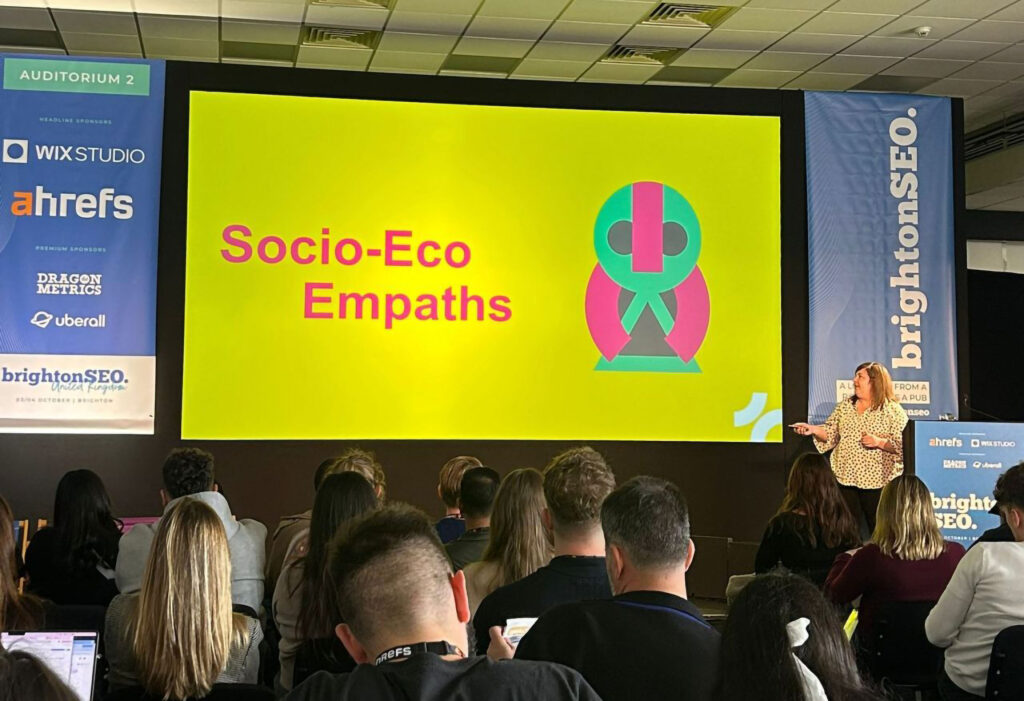Making connections that support women investing in their futures
Historically, the marketing of banking services has been male focused and dominated. Not viewed as the breadwinners or the investors, women have been largely ignored by the financial services industry.
This has led to many women shying away from investing and playing a part in their future financial security. Women are less likely than men to have stocks and shares1 and face a much more uncertain future having typically invested less into their pensions. Women enter the workplace with a pensions gap of 17% due to ongoing gender pay imbalances but leave the workforce on average with a pension gap of 56%. Beyond that, the financial impacts of COVID and the global pandemic disproportionately impacted women2, through the loss of part-time work, pay freezes and the fact women have fewer savings. The effect of this stretches right into the cost of living crisis and economic turmoil we are seeing in the UK today.
However, when women do invest, they consistently outperform men when it comes to getting long term returns3. So why have they been ignored by the financial services sector and how can you bring them into the fold?
At Sticky we’ve taken a deep dive into this sector and have some simple ways in which we can shape your communications strategy to develop coherent messaging which includes and empowers women.
In summary:
- Multiple barriers to women still exist in the financial world – it is up to you to break them down
- Change your tune to attract a new audience – speak the language of your audience,
- Financial content is bland – change it
- Women aren’t bad with money – you’ve just been taught they are
- B2B is leading the way – celebrate these wins, and learn from them
- Be easy to find – undiscovered content is a waste of marketing budget
- Female financial influencers are on the rise – tap into a growing sector
- You can’t be what you can’t see – be inclusive
- Life moments matter – build content around the things that matter to people not your brand
- Place female voices first.
Making the connections
1. Multiple barriers to women still exist in the financial world
Kantar’s Winning Over Women study (2017) highlighted that over 25% of women still face barriers to financial investing. These range from it simply being more expensive to be a woman in western society4, compounded with the pay gap resulting in lower levels of disposable income in women than men, to the language and attitudes of the traditional mainstream banks and financial institutions. With these barriers in place, it is the duty of the financial institutions, not women themselves, to break them down.
Investment platforms such a Investing for Girls and Nutmeg use clear signposting and foster both inclusive and dedicated spaces for women to explore financial opportunities.
Simple changes to the language of your site can help create an equally inclusive space and open the doors to women, building your credibility and diversifying your portfolio. Taking the time to create barrier-breaking content that allows women to learn and develop investment skills in a supportive space will also increase accessibility.
2. Change your tune to attract a new audience
There are many subtle yet clear differences in how men and women communicate and use language. Women today speak in many different ways. Almost none of which are represented in gender-neutral language that skews traditionally masculine. For example, many are bold brash, and unashamed. Something that Financielle knows all too well. Their blog includes fearless, empowering titles such as F**k off funds and why they are important.
But remember, you don’t need to be Financielle. After all, it would be bizarre if Santander started dropping the F-bomb. But in order to attract more women to your business you need to speak to them as humans and celebrate the vast array of experiences, knowledge, and questions they may have.
3. Financial content is bland
If we’re being honest with ourselves, financial content is rarely inspiring. The technicalities of interest rates, loans and financial products are, quite rightly, tightly regulated to protect the consumer. However, there is still room for creativity, especially in the look and feel of your website or app. The finance sector is awash with traditional blues and greens designed to inspire trust and respect, but consumers today (especially female consumers) are looking for a more empathetic approach.
Apps such as Nude are using a softer colour palette and combining it with natural (i.e., not jargon-filled) language. Colour palettes such as these are often associated with health and wellness brands and as financial wellness grows in importance this design overlap can help encourage women to invest their time in researching your brand and ultimately their finances.
4. Women aren’t bad with money – you’ve just been taught they are
Starling Bank’s Make Money Equal campaign (2018)5 found that across the media and financial institutions men make money, but women are thrifty and scrape together small pots of cash. It also tied men’s financial success to earnings while women’s finances were predominately domestic. By framing the conversation in this way, the majority of us have been trained to think of financial investments and generating income as man’s work and something women needn’t be interested in.
The truth is we know female investors consistently outperform their male counterparts. That’s according to Forbes and global investment funds such as Fidelity.
Champion women investors in your communications, if in doubt examine the use of pronouns across your site and see how the tone changes when you switch them. You may surprise yourself.
In a twist to what we would perhaps expect, when communicating with women many banks are more empowering and supportive to female business owners. The language used and approach is much stronger and direct when talking to female business customers compared to the private account holder.
5. B2B is leading B2Women
Barclays,6 for instance, has dedicated tools for the female entrepreneur, while their B2C channels have little to no female-focused content. So, we know banks and institutions do know how to communicate effectively with women, they just need to share their successes across the business.
6. Be easy to find
Content that no one can find is a waste of marketing spend. Place your inclusive content front and centre. Challenger banks and businesses are creating strong female-led content, but it’s often difficult to find. A search through Starling bank’s blog unearths some amazing female-centric content, but it’s not always easy to find.
Having the strength to place this content front and centre will resonate with an audience on the lookout for diverse content. Beyond this, utilise traffic drivers to bring people to this latest content.
7. The rise of female financial influencers
There are already many female voices in this space. There is nothing wrong with leaning into their expertise. Fidelity used the influencer agency SheSpeaks on a brand building campaign for its Women Talk Money community7. The campaign featured several women talking directly to their audience about important financial matters. The results saw the Fidelity community grow from 100,000 to 200,000 members, and 75% of traffic came from social media.
Working with these key opinion leaders and experts will allow your brand to access their community, and support female entrepreneurial minds while also improving accessibility to your own content.
8. You can’t be what you can’t see
The financial world is awash with white men in suits holding important looking folders. It’s time for a change. As previously mentioned, Starling Bank are working to increase the number of stock images including women. But it goes beyond that. Allowing consumers to see themselves in brand messaging can convert into as much as a 30% uplift in consumer trust8.
When building your website, social media, and other consumer touchpoints, it’s essential to have naturally diverse images that represent the wider community.
Diversity in images is no longer a nice to have, it is expected by the consumer.
9. Life moments matter
Kantar’s Winning Over Women research shows that women respond to financial content that gives context to information and planning moments. This includes specific life moments and times when financial planning is essential. Fidelity tapped into this in their influencer campaign and NatWest’s Life Moments provide such a launch point.
However, the traditional linear progression of life stages has evolved, new milestones and moments are being shared. Content that explores these new moments is likely to resonate with women. These touchpoints can include career breaks to travel, having children in their 40s, second marriages and more.
10. Put female voices First
Only 41 of the Fortune 500 companies are led by women. In 2020 globally women made up only 5% of all CEOs.9 Globally women hold only 12% of CFO positions10. This imbalance in the boardroom is echoed in financial communications. Placing women at the forefront of the conversation is disruptive and progressive, but also essential.
Fidelity’s Women Talk Money programme does this and allows the brand to have a genuine point of difference. Centring women’s voices in the financial services space creates a sense of belonging and helps ensure greater relevancy. When creating content, building stories or hosting roundtables, ensure your creators and key opinion leaders are at least 50% women.
How Sticky can help
Working with you, Sticky can strengthen your brand communication and help you reach out to a consumer group previously ignored by the financial services industry in a natural and engaging way. Using innovative traffic drivers, we’ll get your content in front of those who need to see it. Beyond that we’ll work with you to inspire the curious mind of a group of investors who have a proven track record of outperforming the market.
1 10% of women have a stocks and shares ISA compared to 17% of men
2 https://www.unwomen.org/en/news/stories/2020/9/feature-covid-19-economic-impacts-on-women
3 https://www.forbes.com/advisor/investing/woman-better-investors/
4 https://monzo.com/blog/the-extra-cost-of-being-a-woman
5 https://www.starlingbank.com/docs/reports-research/MakeMoneyEqual-Research.pdf
6 https://www.barclays.co.uk/business-banking/sectors/women-in-business/#tools
7 https://www.prnewsonline.com/influencers-help-fidelity-investments-with-financial-education-campaign/
8 https://www3.weforum.org/docs/WEF_Benchmarking_Diversity_and_Inclusion_in_Media_and_Entertainment_2022.pdf
9 https://www.smallbizgenius.net/by-the-numbers/male-vs-female-ceo-statistics/#gref
10 https://www.stemwomen.com/women-in-financial-services-the-case-for-gender-diversity



